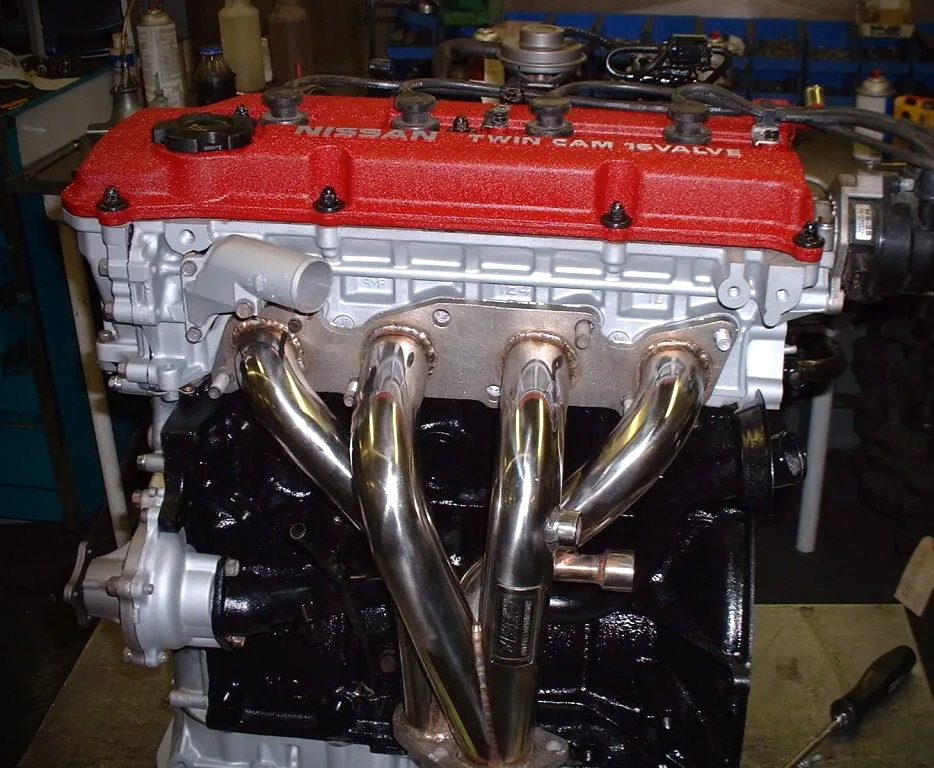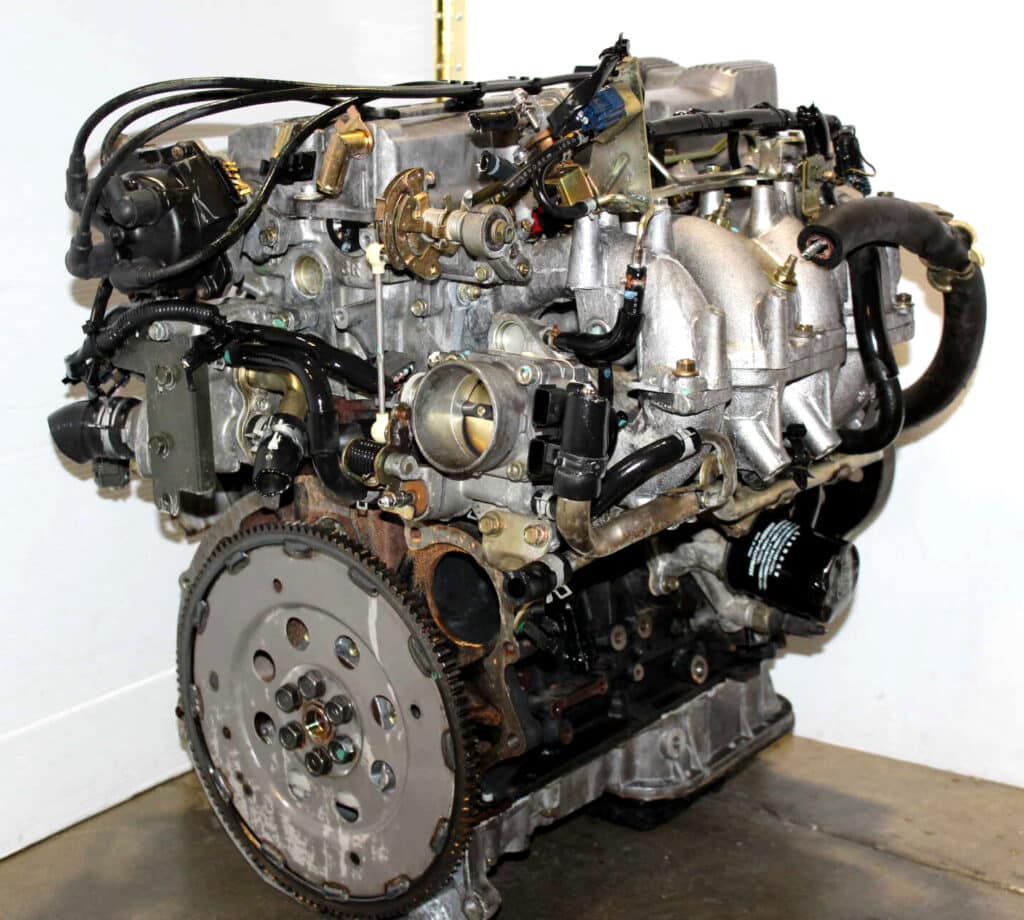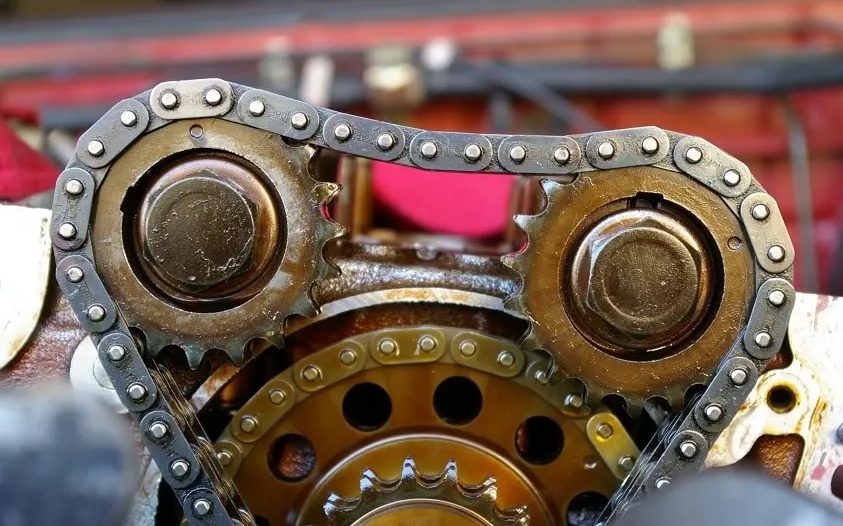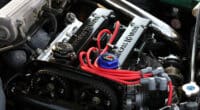If you live in the States and you’re into drifting, chances are you’re already very familiar with Nissan’s KA24DE engine.
This motor first saw the light of day in 1988, when it replaced the older Z24 unit. Originally called the KA24E, it was installed in the 1989 and 1990 year models of the Nissan 240SX.
The KA24E wasn’t a particularly good engine at the time; the SOHC 12-valve unit severely lacked the kind of power that you’d typically expect from a sports car.
Nissan implemented a solution to this and gave us the KA24DE, which saw numerous upgrades compared to its predecessor, making it a far superior unit.
However, it’s important to remember that Nissan’s original intention for the KA24DE was for it to power trucks and SUVs; it was never designed for small sports cars.
Luckily, enthusiasts soon realized that the KA24DE could handle more power, much more. In this article, we’ll take a closer look at the now-legendary Nissan KA24DE engine.
We’ll cover why it amassed such a cult-like following, what cars have a KA24DE engine, and how gearheads can extract its true potential.
Nissan KA24DE Specs

- Engine code: KA24DE
- Layout: Inline-4, DOHC, 16-valve
- Displacement: 2.4L (2,389 cc)
- Fuel system: EFI
- Cylinder bore: 89 mm
- Piston stroke: 96 mm
- Compression ratio: 9.5:1, 9.3:1, 9.2:1
- Power: 143 hp at 4,300 rpm to 155 hp at 5,600 rpm
- Torque: 153.3 lb-ft at 3,600 rpm to 159.9 lb-ft at 4,400 rpm
- Firing order: 1-3-4-2
The KA24DE is a DOHC 16-valve engine. Compared to the KA24E’s 9.1:1 compression ratio, the DE was bumped up to 9.5:1.
It has larger inlet valves, upgraded pistons and crankshaft; a knock sensor, a different oil pan, and piston oil squirters, among other things.
All of this means that the KA24DE revs 400 rpm higher than the KA24E, with a redline of 6,900 rpm. It produces 155 hp and 160 lb-ft, which is a significant step up from 134 hp and 152 lb-ft.
While those aren’t terrible figures for a naturally aspirated 2.4-liter engine from that era, it doesn’t qualify as proper sports car power. Even though its cast-iron block provides excellent reliability, it also adds a lot more weight.
One of the reasons why Nissan went with the cast-iron cylinder block was to save money, which meant the 240SX could be offered at a bargain basement price.
Here’s what the KA24DE engine code stands for:
- KA: Represents the engine series
- 24: 2.4-liter displacement
- D: DOHC or Dual Over Head Camshaft
- E: Electronic fuel injection
The KA24DE was never fitted with a turbocharger from the factory. However, in true Nissan fashion, some enthusiasts also like to add a “T” at the end when they fit a turbocharger, making it a KA24DE-T.
What Cars Have a KA24DE Engine

Taking a closer look at what cars have a KA24DE engine, you’ll quickly realize how capable this unit really was. It was found under the hood of everything from sports cars, classic cars, and even SUVs.
Some of these include:
- Nissan 240SX
- Nissan Bluebird
- Nissan Altima
- Nissan Pathfinder
- Nissan Xterra
- Nissan Bassara
- Nissan Caravan
- Nissan Hardbody
- Nissan Navara
- Nissan Pintara
- Nissan Prairie
- Nissan Presage
- Nissan R’nessa
- Nissan Serena
- Nissan Stanza
- Nissan Terrano II
Most of these are in no way, shape, or form considered to be performance cars. Nevertheless, we can’t help but wonder how much power a KA24DE can handle, and what are the best ways to extract more power.
Tuning the KA24DE Engine
Owing to the 240SX being one of the most affordable drift cars (before prices skyrocketed), it would soon find itself going sideways around racetracks during drifting competitions.
Obviously, such shenanigans require a bit of power, and enthusiasts soon figured out the best ways to extract every ounce of performance from this motor.

Before you start a KA24DE build, we highly recommend that you have it inspected to ensure it’s in good condition.
The first thing to do is to check the compression in every cylinder. You want to see 150 psi at the very least; around 180 psi is standard. This can be done with the help of an engine compression tester.
Throwing money at an engine that’s already damaged can be a source of endless headaches and frustration.
Once you’re sure your KA24DE motor will hold up, you need to decide whether you’ll keep it naturally aspirated or install a turbo.
A naturally aspirated, properly built KA24DE can pump out roughly 200 whp, but be warned that getting it to that point won’t be cheap.
In order to get there, you’ll need every bolt-on upgrade you can get your hands on, as well as some upgraded internals.
A short ram or cold air intake is required to suck in as much air as possible, then you’ll need aftermarket headers, an upgraded exhaust system, and straight pipes if that’s your thing.
Fit a set of bigger cams, get the head ported and polished, install a lightweight flywheel, and get the whole thing tuned on a dyno.
If you really want to get the most out of the KA24DE, you’ll want to install a turbocharger or supercharger on there.

Creating your own KA24DE-T can be done in a few different ways, and the rather large 2.4-liter displacement will help spool up the turbo quicker than a smaller engine would.
Some choose to go with off-brand turbos or an old turbo from another engine, others go with brand new kits made exclusively for this engine.
Both options can be affordable and reliable, but we think it’s better to use a properly engineered turbo kit.
The KA24DE is a very solid unit, with a strong crankshaft and con rods, so it can handle around 300 hp before you need to worry about upgrading internal components.
Once you’ve upgraded the internals, aftermarket turbo kits can push power beyond 400 hp. Some gearheads have even managed to tease out closer to 1000 hp from their KA24DE build.
KA24DE Reliability and Common Issues
If you keep your KA24DE stock, it’s practically bulletproof, all thanks to its simplicity, cast iron block, aluminum cylinder head, and fairly low compression.
If the engine has been well-maintained, and you service it regularly, you can probably enjoy years of driving without experiencing any serious issues.
Most problems that owners experience with the KA24DE are age-related, so you should expect old components to eventually fail.

Strictly speaking, that’s not a weakness of the engine, though. It’s just a fact that each component found on an engine has an estimated lifespan, and the same is true for every other engine out there.
On the list of potential issues, you’ll likely run into valve cover gasket failure, distributor failure, and timing chain rattle, all of which can be fixed relatively easily.
Valve cover gasket failure can happen if the car lives a hard life, constantly bouncing off the rev limiter.
However, the most likely cause is just that it’s old. As a cheap insurance, we strongly suggest installing a new valve cover gasket if you don’t know how old the current gasket is.
Be aware of the smell of burning oil, oil leaking around the valve cover and engine block, or any signs of the engine not running right.
A new valve cover gasket is cheap, and you can find DIY tutorials on YouTube. It shouldn’t take you more than an hour or two to fix it.
If the distributor fails, it’s pretty much guaranteed that it’s because of age. Common symptoms include rough idling, problems starting the engine, and a whining noise.
New distributors are readily available, they’re relatively affordable, and it shouldn’t take more than 30-45 minutes to fix them, even for the inexperienced.
If you’ve replaced the distributor but the engine still misfires, you need to check for symptoms of spark plug failure and replace the spark plugs if required.
The final problem with the KA24DE is that of timing chain rattle, which can lead to more serious problems if not dealt with.

Basically, this problem can be blamed on the KA24DE’s construction. It’s a four-cylinder engine that uses a flat-plane crank, and engines like this usually have balancer shafts.
This is not the case with the KA24DE, and it can develop a problem caused by the timing guides rubbing against the valve cover.
It usually starts out as an annoying rattling noise, and from there, it gets progressively worse, until the timing chain either jumps the timing or splits, causing serious internal damage in the process.
For this reason, you should get that rattling noise sorted out as soon as possible, as there are no other clues that it might fail.
The good news is that it’s fairly straightforward to solve. Often, the noise comes from a broken timing guide. In that case, Nissan claims that it’s safe to remove the timing guide and drive without it.
If that doesn’t solve the problem, the problem lies with another component in the timing chain system. Replacing the upper chain, tensioner, and guide should definitely solve it.
As long as you keep an eye and ear out for these issues, KA24DE ownership shouldn’t cause you any problems.
SR20 vs KA20DE
When Nissan introduced the 240SX to the North American market in 1989, they went with a different formula than the S cars sold in other markets.
In Japan, Nissan had the Silvia and 180SX, and in Europe and Australia, it was sold as the 200SX. The 240SX stock engine was the only one that didn’t have a turbocharger.
For that reason, comparing the SR20 with the KA24 may not seem fair, and it isn’t. That said, if you turbocharge the KA, things will start to make a lot more sense.

First of all, every gearhead knows that there’s no replacement for displacement, and we already mentioned how the torquey KA24DE-T will have no problems spooling up a turbo.
Next, there’s the KA’s iron block, which is much stronger than one made from aluminum, although it does come with a weight penalty. The KA24’s head has an even better flow than that of the SR20DET.
All things considered, we’d still argue that the SR20DET is better than the KA24DE-T.
While the KA unit can be turned into a real performance monster, a lot of these engines have been pushed to within an inch of their lives, meaning that solid iron block may have been pushed beyond its limit.
Sure, it’s possible to build a powerful and reliable KA24DE-T engine, but even the aftermarket doesn’t offer anywhere near the same amount of parts as it does for the SR20.
The final nail in the KA’s coffin is the fact that the SR20DET was designed to be a turbocharged high-performance Nissan engine, while the KA24DE was just a truck engine — almost agricultural in comparison.
It’s getting harder to find a good and cheap Nissan SR20 engine these days though, so if you already have a KA24, it may just be better to tune that rather than going for a swap.
Concluding Thoughts

The Nissan KA24DE is a simple and solid, but somewhat underperforming engine.
In fact, the main reason behind its greatness is its simplicity, since it has no groundbreaking technology or bells and whistles that are nothing more than additional points of failure.
Those willing to go for a proper KA24DE tune and build can definitely create a beast that’s more than capable of keeping up with much more expensive machinery.
Be warned, though, that adding turbos will make things more complex and it might negatively affect what makes the engine so good in the first place.
If you decide to do a KA24DE build, don’t skimp on maintenance, avoid taking things too far, and you’ll have a reliable engine that’s also easy to work on.
Enjoyed reading this post? Share it with your friends on Facebook, Reddit, and your favorite car forums. We appreciate your support!

